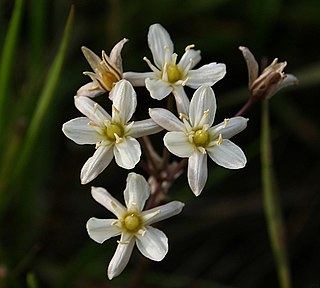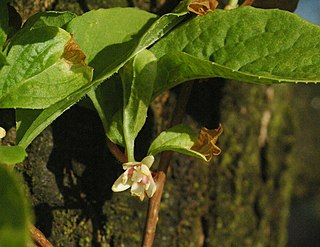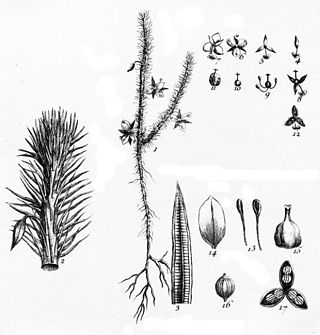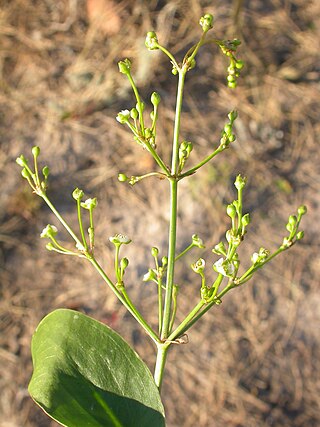
The Santalales are an order of flowering plants with a cosmopolitan distribution, but heavily concentrated in tropical and subtropical regions. It derives its name from its type genus Santalum (sandalwood). Mistletoe is the common name for a number of parasitic plants within the order.

Ceratophyllum is a cosmopolitan genus of flowering plants including four accepted living species in 2016, commonly found in ponds, marshes, and quiet streams in tropical and in temperate regions. It is the only extant genus in the family Ceratophyllaceae, itself the only extant family in the order Ceratophyllales. They are usually called coontails or hornworts, although hornwort is also used for unrelated plants of the division Anthocerotophyta.

The Piperaceae, also known as the pepper family, are a large family of flowering plants. The group contains roughly 3,600 currently accepted species in 5 genera. The vast majority of species can be found within the two main genera: Piper and Peperomia.

Brodiaea, also known by the common name cluster-lilies, is a monocot genus of flowering plants.

The genus Muilla includes four to five species of flowering plants.

Nartheciaceae is a family of flowering plants. The APG III system places it in the order Dioscoreales, in the clade monocots. As circumscribed by APG IV (2016) it includes 35 species of herbaceous plants in the following five genera:

The Potamogetonaceae, commonly referred to as the pondweed family, is an aquatic family of monocotyledonous flowering plants. The roughly 110 known species are divided over six genera. The largest genus in the family by far is Potamogeton, which contains about 100 species.

Sparganium (bur-reed) is a genus of flowering plants, described as a genus by Linnaeus in 1753. It is widespread in wet areas in temperate regions of both the Northern and Southern Hemispheres. The plants are perennial marsh plants that can grow to 3.5 m, with epicene flowers.

Schisandraceae is a family of flowering plants with 3 known genera and a total of 92 known species. Such a family has been recognized by most taxonomists, at least for the past several decades. Before that, the plants concerned were assigned to family Magnoliaceae and Illiciaceae.

Mayaca is a genus of flowering plants, often placed in its own family, the Mayacaceae. In the APG II system of 2003, it is assigned to the order Poales in the clade commelinids. The Cronquist system, of 1981, also recognised such a family and placed it in the order Commelinales in the subclass Commelinidae.

Cypripedium californicum, the California lady's slipper, is a member of the orchid genus Cypripedium, the lady's slipper orchids, native to the western United States.

Aletris, the colicroot, colicweed, crow corn, or unicorn root, is a genus of flowering plants in the family Nartheciaceae, native to North America and to eastern and southeastern Asia, especially China. It was used as a component in Lydia Pinkham's original Vegetable Compound.

Toxicoscordion micranthum, the smallflower deathcamas, is a flowering plant in the genus Toxicoscordion. It is native to Oregon and California, primarily in the Coast Ranges from Douglas County to Napa and Sonoma Counties, with isolated populations in Lassen, Plumas, Santa Clara, and San Benito Counties. It is a member of the serpentine soils flora.

Butomus is the only known genus in the plant family Butomaceae, native to Europe and Asia. It is considered invasive in some parts of the United States.

Oncotheca is a genus of tree endemic to New Caledonia. There are two species, Oncotheca balansae and Oncotheca humboldtiana.

Alisma triviale, the northern water plantain, is a perennial semi-aquatic or aquatic plant in the water-plantain family (Alismataceae).

Triantha is a small genus of flowering plants in the family Tofieldiaceae, first described as a genus in 1879. False asphodel is a common name for plants in this genus.

Lophiola is a genus of monocotyledonous flowering plants native to eastern North America. It has variously been placed in the Liliaceae, the Haemodoraceae, the Tecophilaeaceae or the Nartheciaceae.

Pleea is a small genus of flowering plants described as a genus in 1803. There is only one known species, Pleea tenuifolia, the rush featherling, native to the southeastern United States.
Polygonum spergulariiforme is a North American species of flowering plants in the buckwheat family known by the common name spurry knotweed or fall knotweed. It grows in western Canada and the western United States.



















